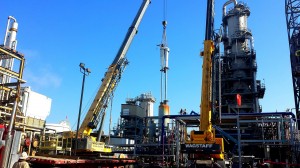The March 2015 American Fuel & Petrochemical Marketers Association (AFPM) Annual Meeting (www.afpm.org) in San Antonio, Texas weighed in on the newest refinery opportunities and challenges. Overall, the U.S. downstream refining and petrochemical industry will continue to benefit from favorable margins while refiners in other major regions, such as Asia and Europe will face significant challenges. The overall consensus at the AFPM Annual Meeting was on the need to reconsider technology investment strategies influenced by a shifting transportation fuels and petrochemical products balance. However, there seems to be a lack of “enablers” in the form of process technology and linked automation for refiners to simultaneously meet both transportation fuel and petrochemical product specifications.

Upgraded high complexity refinery units.
Partly depending on process complexity and market exposure, the refiner could be better served focusing on either transportation fuels production (e.g., ULSD) or petrochemicals expansion (e.g., propylene), but not both. However, widening margins differentials between fuels, such as gasoline, and naphtha based petrochemicals (e.g., olefins) has encouraged certain U.S. based fuel refineries to expand into petrochemical feedstock production and give them a hedge against crude feedstock price volatility. According to a presentation from UOP’s Keith Couch, “the value uplift of petrochemicals is remarkably stable despite significant fluctuations in crude oil prices.” So, while the upstream oil and gas industry is currently in a state of investment paralysis, U.S. refiners are significantly expanding their portfolio of exportable products. Market demand (e.g., gasoline demand in Latin America and olefins demand in Asia) and low energy costs in North America make exports from medium sized American refineries competitive with exports from world-scale Middle East refineries.
While the new narrative in the North American refining industry revolves around refined product exports, ranging from condensate to aromatics and polymers, export focused Middle Eastern refiners, such as the world-scale 400,000 bpd facilities in Saudi Arabia, are targeting investments for meeting higher domestic fuel product demand. For example, many Middle East refiners are targeting maximum propylene production and maximum fuels production. Is that possible? Of course, desired FCC yields are a function of many parameters ranging from higher cat cracker temperature (for olefins production), higher catalyst circulation rate, higher catalyst-to-oil ratio, higher Ecat activity, better feed quality, etc. In summary, a higher unit severity is to be expected, not just for FCC units, but for other key conversion units, such as hydrotreaters and reformers, including the unit’s critical rotating equipment assets, such as the compressors and pumps.
Every sensible forecast shows that the world’s 33 billion barrel per year oil consumption will continue for the foreseeable future. It’s the balance of products that will continue shifting, currently moving away from gasoline and bunker fuels towards distillate range products and on to petrochemicals for supplying the petrochemicals markets. For a specific example, 20 years ago, the ZSM-5 catalyst additive was designed for increasing gasoline yields, while the current onus is on tweaking ZSM-5 additives for increasing yields of propylene, mixed butylenes and isobutene, at the cost of substantially lowered gasoline yields.








Leave a Reply